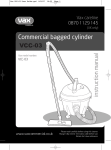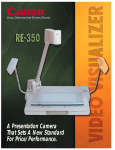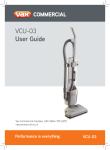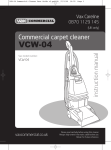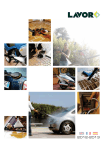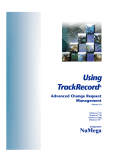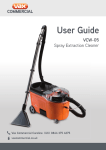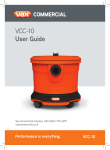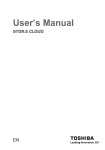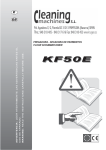Download User Guide VCSD-01 Mains Powered Scrubber
Transcript
User Guide VCSD-01 Mains Powered Scrubber drier VCSD-02 Battery Powered Scrubber drier 0121 347 6047 [email protected] vaxcommercial.co.uk 2 1 - CONTENTS 1 - CONTENTS 2.3 2.4 2.5 7.13.1 7.13.2 2 - GENERAL INFORMATION 2.1 MANUAL PURPOSE 2.2 T E R M I N O L O GY AND SYMBOL LEGEND PRODUCT IDENTIFICATION SPECIFIC USE ECHNICAL MODIFICATIONS 7.13.3 7.13.4 7.13.5 7.14 3 - SAFETY INFORMATION 3.1 BASIC RECOMMENDATIONS 3.2 SCRAPPING OF THE MACHINE 3.3 NOISE AND VIBRATIONS 8 - MAINTENANCE 8.1 TANKS 8.2 SOLUTION FILTER CLEANING 8.3 SUCTION HOSE 8.4 SQUEEGEE 8.5 ACCESSORIES 8.6 MACHINE BODY 8.7 BATTERY* 8.8 THERMAL BREAKERS 8.9 PERIODIC MAINTENANCE 8.9.1 DAILY OPERATIONS 8.9.2 WEEKLY OPERATIONS 8.9.3 OPERATIONS AT EXTENDED INTERVALS 8.10 RECOMMENDED SPARE PARTS 4 - HANDLING INSTRUCTIONS 4.1 PACKING LIFTING AND TRANSPORT 4.2 CHECKS UPON DELIVERY 4.3 UNPACKING 4.4 DIMENSIONS AND WEIGHT OF THE PACKAGING 5 - TECHNICAL INFORMATION 5.1 SYMBOLS USED ON THE MACHINE 5.2 MACHINE STRUCTURE AND FUNCTIONS 5.3 DIMENSIONS 6 - INSTALLATION 6.1 HANDLEBAR POSITIONING 6.2 BATTERY INSTALLATION* 6.2.1 BATTERY CONNECTION* 6.3 BATTERY CHARGER CONFIGURATION* 9 - TROUBLESHOOTING 9.1 THE MACHINE DOESN’T WORK 9.2 THE BRUSH DOESN’T ROTATE 9.3 NOT ENOUGH OR NO CLEANING SOLUTION 9.4 NO SUCTION 9.5 INSUFFICIENT SUCTION 9.6 THE BRUSH MOTOR OR THE SUCTION MOTOR DOESN’T STOP 9.7 THE SQUEEGEE DOESN’T CLEAN OR DRY EFFICIENTLY 9.8 THE BATTERIES DO NOT WORK* 9.9 THE BATTERIES DO NOT CHARGE OR DO NOT HOLD A CHARGE* 7 - OPERATING INSTRUCTIONS 7.1 MACHINE PREPARATION 7.2 BATTERY CHARGING* 7.3 BRUSH ASSEMBLY / DISASSEMBLY 7.4 MACHINE TRANSPORT 7.5 SQUEEGEE ASSEMBLY 7.6 SQUEEGEE DISASSEMBLY 7.7 SQUEEGEE BLADES DISASSEMBLY/ ASSEMBLY 7.8 SQUEEGEE ADJUSTMENT 7.9 FILLING AND DRAINING THE SOLUTION TANK 7.10 DRAINING THE RECOVERY TANK 7.11 ADJUSTING THE SOLUTION WATER FLOW 7.12 DRIVING THE MACHINE 7.13 WORK METHOD * Only applies to VCSD-02 model PREPARATION AND WARNINGS BATTERY CHARGE LEVEL CONTROLS* DIRECT SCRUBBING OR FOR SLIGHTLY DIRTY SURFACES INDIRECT SCRUBBING OR FOR VERY DIRTY SURFACES POST-SCRUBBING OPERATIONS SPECIFIC INSTRUCTIONS FOR THE USE OF VCSD-02 2 2 - GENERAL INFORMATION 2.1 MANUAL PURPOSE To make it easier to read about and look up various subjects, refer to the table of contents at the beginning of this manual. This manual has been prepared by the manufacturer and is an integral part of the product. As such, it must be kept in a safe place for the machine’s en- tire service life until demolition. The customer must ensure that machine operators have read or are familiar with the contents of this manual so that they strictly follow the instructions described herein. Constant compliance with the instructions provided in this manual is the only way to guarantee the best results in terms of safety, performance, efficiency and service life of the product you now own. Noncompliance with these rules may cause injuries to people and damage to the machine, the scrubbed surface and the environment: in no case can such injuries or damage be attributed to the manufacturer. This manual refers in detail to the machine and provides instructions and descriptions only about the battery and the battery charger provided.* 2.2 TERMINOLOGY AND SYMBOL LEGEND For the sake of clarity and to efficiently highlight the various aspects of the instructions provided, terms and symbols were used that are defined and illustrated here below: - Machine. This definition replaces the commercial name to which this manual refers. - Operator. An operator is considered the person who normally uses the machine and is familiar with its operating features but does not have the specific technical skills to work on that machine. - Technician. A technician is considered a person who has the experience, technical education, legislative and regulatory knowledge that allows him to carry out any type of required work, and the ability to recognize and to avoid possible risks during machine installation, operation, handling and maintenance. - INDICATION SYMBOL (☞). Particularly important information to avoid machine malfunctions. - ATTENTION SYMBOL (!). Very important information to avoid serious damage to the machine and to the environment in which it operates. - DANGER SYMBOL ( ◊). Vital information provided to avoid serious (or extreme) consequences affecting the health of persons and causing damage to the product and the environment in which it operates. * Only applies to VCSD-02 model 4 2.3 PRODUCT IDENTIFICATION The nameplate located in the backside of the machine contains the following information: • Manufacturer ID • CE mark • Model code • Model • Overall power rating • Serial number • Year built 2.4 SPECIFIC USE This machine is a floor scrubber-drier: it must be used to scrub and to vacuum liquids of flat, rigid, horizontal, smooth or moderately rough and uniform floors that are free from obstacles in both civic and industrial environments. Any other use is prohibited. Please refer very carefully to the safety information reported in this manual. The scrubber-drier distributes a quantity of a water and detergent solution (adjustable) on the surface to be cleaned, while the brushes remove any dirt on the ground. The machine’s suction system, using a ground squeegee, perfectly dries the liquids and the dirt just removed from the front brushes in a single pass. By efficiently combining a cleaning detergent with various types of brushes (or abrasive disks), the machine can adapt to all the various combinations of floors and dirt. 2.5 TECHNICAL MODIFICATIONS This machine was designed and built in accordance with the fundamental requirements for user safety and health as set forth in European directives. For this reason the CE mark was placed on the ID label. The European directives to which the equipment conforms are referenced are available upon request. This certificate will become invalid if the equipment is modified in any way without the manufacturer’s prior authorization. The manufacturer reserves the right to make technical modifications to the product, without prior notice, in order to make the necessary technical upgrades or improvements. For this reason, some details of your machine may be different from the information in the sales catalogues or from the illustrations presented in this booklet. However, this will not reduce safety or invalidate the information supplied to this regard. 3 - SAFETY INFORMATION 3.1 BASIC RECOMMENDATIONS (☞) Carefully read the “instruction manual” before starting, using, performing unscheduled or routine maintenance or any other work on the machine. (! ) Rigorously comply with all the instructions provided in this manual and in those for the batteries and battery chargers (with particular attention to warnings and danger notices).* The manufacturer will not be held responsible for injuries to persons or damage to property due to non-compliance with the aforementioned instructions. (☞) Before using the machine, make sure that each part is in the correct position. (! ) The machine should only be used by personnel who have received appropriate training. To avoid unauthorized use, keep the machine in a place that denies access to unauthorized personnel when not being used and remove the key from the control panel. (! ) This commercial appliance can be used by those under 16 (but not below 8) years and persons with reduced physical, sensory or mental capabilities or lack of experience and knowledge if they have been given instruction concerning use of the appliance in a safe way and understand the hazards involved. Cleaning and user maintenance shall not be performed without supervision. (! ) Do not operate this machine for any other purpose except for the use for which it was specifically designed. Evaluate the type of building where it will be utilized and rigorously comply with the current safety regulations and conditions. (◊) Do not use the machine in places without adequate lighting, in explosive environments, when harmful dirt is present (dust, gas, etc.), on roads or public passageways and in outdoor environments in general. ( ! ) The machine operating temperature range is +4°C to +35°C; when not being used, store the machine in a dry and non-corrosive environment within a temperature range of between + 10°C and +50°C. When using the machine under any condition the humidity must range between 30% and 95%. (◊) Never use or vacuum liquids, gases, dry dust, acids and solvents (e.g. paint thinners, acetone, etc.), even if diluted, inflammables or explosives (e.g. petrol, fuel oil, etc.); never vacuum flaming or incandescent objects. ( ! ) Do not use the machine on slopes or ramps steeper than 2%. For small slopes, do not use the machine sideways, always handle it with caution and never move backwards. When transporting the machine on steeper ramps or slopes, be very careful to avoid tipping and/or uncontrolled accelerations. * Only applies to VCSD-02 model 5 The machine can be handled on ramps and/or steps only with the brush head and squeegee lifted off the ground. (!) Never park the machine on a slope. (☞) Never leave the machine unattended with the key in and connected; it may be left only after having disconnected it and taken the key out and guaranteeing against accidental movements and, if necessary, disconnecting it from the electrical power supply. (◊) Make sure there are no other persons, and children in particular, in the area where the machine is being used. (!) Do not use the machine to transport persons/things or to tow objects. Do not tow the machine. (☞) Do not use the machine as a support surface for any weight for any reason. (☞) Do not block or cover any openings (!) Do not remove, modify or by-pass the safety devices. (!) The appropriate Personal Protective Equipment should be worn to operate the machinery and protect the user. This should be in accordance with an appropriate risk assessment prior to its first use. Before starting to work, remove necklaces, watches, ties and other objects that may cause serious injuries. (!) Do not insert hands between moving parts. (☞) Do not use detergents that differ from those recommended and follow the instructions indicated on the chemical’s relevant safety d at a sheets. Follow all storage, disposal and safety instructions of each individual or group of detergents as listed on the product. (!) Make sure that the battery charger power sockets are connected to an efficient earthing system and that they are protected by magneto thermal and differential circuit breakers.* (!) Follow the battery manufacturer’s instructions and comply with safety instructions and legal provisions. The batteries should always be clean and dry to avoid surface leakage currents. Protect the batteries against impurities, such as metallic dust.* (◊) Do not place tools on top of the batteries: they may cause a short-circuit or an explosion. (◊)Never spray water on the machine to clean it. (☞) Recovered fluids contain detergents, disinfectants, water, as well as organic and inorganic material collected during work operations: dispose of them in accordance with current legal provisions. 3 - SAFETY INFORMATIONS Each homogeneous group must be accordance with recycling laws. In recommended to eliminate those machine that may be dangerous, children. (! ) If the machine malfunctions and/or operates inefficiently, turn it off immediately (disconnecting from the electric power supply or from the batteries) and do not tamper with it. Contact the Vax contact centre. (◊) All maintenance or accessory replacement operations must be carried out in environments with adequate lighting and only after having disconnected the machine from the electric power supply or by detaching the battery connector. (☞) All work on the electrical system and all maintenance and repair operations (especially those not explicitly described in this manual) should be carried out only by authorized service centers or by specialized technical personnel who are experts in the sector and in the pertinent safety regulations. (☞) The machine owner can only use original accessories and spare parts supplied exclusively by the manufacturer since such parts are the only ones that guarantee that the equipment will operate safely without any problems. Do not use parts disassembled from other machines or other kits as spare parts. disposed of in addition, it is parts of the especially for As owner of an electrical or electronic product, you are not allowed by law (according to EU-Directive 2002/96/EC of 27 January 2003 on waste electrical and electronic equipment and the particular national laws of the EU-Member States transforming this Directive) to dispose of this product or its electrical/electronic accessories as unsorted domestic waste. You shall use the designated gratis possibilities for re- turn instead. 3.3 NOISE AND VIBRATIONS - Acoustic pressure: LpL = 73 dB - Acoustic power measured: LwA = 82 dBA - Acoustic power granted: LwA = 83 dBA - Vibrations: 0,29 m/s² (Uncertainty ±15%) (☞) Before each use, check the machine and, in particular, check that the battery charging cable and the connector are in perfect condition and safe for use. If they are not in perfect condition, do not use the machine for any reason until an authorized specialist repairs the defective parts. (☞) Do not use the machine on textile flooring, such as rugs, carpeting, etc. (☞) If foaming or leakages occur, immediately turn off the suction motor. Wax, foaming detergents or dispersions along the hoses may cause serious problems for the machine or clog the hoses. 3.2 SCRAPPING OF THE MACHINE If the machine will no longer be used, remove the batteries and dispose of them in accordance with the eco-compatibility regulations as set forth in European standard 91/157/EEC or deposit them in an authorized collection centre. To dispose of the machine, comply with the current laws where it is used: - disconnect the machine from the mains and clean it after emptying any liquids; - separate the machine into groups of homogeneous materials (plastics in accordance with the recycling symbol, metals, rubber, packing). For parts containing different materials, contact the competent authorities; 6 4 – HANDLING INSTRUCTIONS 4.1 PACKING LIFTING AND TRANSPORT During all lifting or transportation make sure that the packed machine is securely anchored to prevent it from tipping over or falling accidentally. Transport vehicle loading and unloading operations must be carried out with adequate lighting and by trained professionals only. The packed machine must be handled using adequate devices, making sure not to damage/strike any part of the packing, not to tip it over and to be very careful when placing it on the ground. (☞) All these instructions also apply to the batteries and the battery charger. * 4.4 DIMENTIONS AND WEIGHT OF THE PACKING 4.2 CHECKS UPON DELIVERY (☞) When the goods are delivered (machine, battery or battery charger) by the transporter, carefully check the condition of the packing and its contents. If the contents have been damaged, notify the transporter and reserve the right, in writing (select the word “reserve” on the document), to submit a claim for compensation before accepting the goods. 4.3 UNPACKING (! ) Wear safety clothing appropriate to those identified by a qualified risk assessment. The machine is packed with in a cardboard housing placed on a wooden crate; to unpack the machine carry out the following steps: - Use scissors or clippers to cut and eliminate the plastic straps. - Slip off the cardboard housing from the top of the packed machine. - Remove the envelops inside and check their contents (use and maintenance manual, battery charger connector*, power cable**) - Remove the metallic brackets or plastic straps that secure the machine to the pallet. You will require an adjustable spanner or socket set to do this. - Take out the scrubber pad from the packaging (the squeegee is already attached to the unit) - Take the machine off the pallet (pushing it backward) by using an inclined surface that is solidly attached to the floor and to the pallet. It is recommended to keep all the pieces of the packing since they might be useful in the future to protect the machine and the accessories during transport to another location or sent for evaluation/repair. If not, the packing can be disposed in accordance with current disposal laws. * Only applies to VCSD-02 model ** Only applies to VCSD-01 model 7 Volume: Weight: 0,38 m³ Model VCSD -01 53 kg Model VCSD -02 (with battery) 61kg Model VCSD -02 (without battery) 41.5 kg 5 – TECHNICAL INFOMATION 5.1 SYMBOLS USED ON THE MACHINE General ON/OFF switch Brush motor switch Suction motor switch Solenoid valve switch Symbol of the solution water flow adjustment Symbol of the recovery tank drain hole Symbol of the squeegee lifting/lowering 8 5 – TECHNICAL INFOMATION 5.2 MACHINE STRUCTURE AND FUNCTIONS# A B C C A D Photo 3 Photo 1 A) Handlebar A) Suction filter B) Recovery water tank B) Automatic shut-off float C) Suction compartment cover C) Recovery tank inspection plug D) Solution water tank B B A A Photo 4 Photo 2 A) Control lever A) Handlebar release pedal B) Suction hose B) Squeegee lifting/lowering lever # Images shown may vary from the final product 9 5 – TECHNICAL INFOMATION Model VCSD-01 A) General ON/OFF switch B) Suction motor switch C) Solenoid valve switch for solution water outlet D) Brush motor switch Model VCSD-02 A) Suction motor switch B) Solenoid valve switch for solution water outlet C) Brush motor switch C Model VCSD-02 Model VCSD-01 A) Power supply cable A) General ON/OFF key / battery cut-out switch B) Protecting cap C) Battery charger 10 # Images shown may vary from the final product 5 – TECHNICAL INFOMATION 5.3 DIMENSIONS All dimensions are in centimetres. 114 81 79 11 6 - INSTALLATION 6.1 HANDLEBAR POSITIONING To place the machine handlebar in the working position (handlebar opened) it is necessary to operate the handlebar release pedal (Photo 9 - A); press the pedal, pull the handlebar towards you and place it in the appropriate working position. The handlebar can be set in three fixed positions: one “handlebar closed” position for the machine storage or the machine transportation (Photo 10) and two “handlebar opened” working positions (Photo 11 and Photo 12). A Photo 9 Photo 10 Handlebar closed position Photo 11 Handlebar opened - middle position. To operate in small spaces it is recommended to set the handlebar in this position. Photo 12 Handlebar opened 12 6 - INSTALLATION 6.2 BATTERY INSTALLATION* The battery compartment is placed underneath the recovery tank (Photo 14) and to access it, it is necessary to remove the recovery tank. To remove the recovery tank, detach the suction hose from its housing (Photo 4 - B) and lift the tank by pulling it up as shown in Photo 13. Place the battery in the battery compartment (Photo 14) checking that it is in perfect condition. 6.2.1 BATTERY CONNECTION* (◊) Attach the battery wiring to the battery, connecting the terminals only on the poles marked with the same symbol (red wiring “+”, black wiring “-“) as shown in the connection diagram in Photo 15. Photo 13 (◊)Take care to avoid short circuits over the battery terminals After checking that all the controls on the panel are in position “0” or at rest, connect the battery connector to the machine connector (Photo 16 B). Photo 16 shows the correct battery connection. ( ! ) Close the battery compartment, replacing the recovery tank, making sure not to crush any wire. 6.3 BATTERY CHARGER CONFIGURATION* ( ! ) The machine is equipped with a battery charger configured for ENERSYS maintenance free battery. We recommend that you use an ENERSYS battery as replacement. Use of any other battery may affect the warranty of the product. Photo 14 A Photo 15 D A) 12V Battery with cabling B) Battery connector C) Suction motor thermal breaker B C D) Traction motor thermal breaker Photo 16 * Only applies to VCSD-02 model 13 7 – OPERATING INSTRUCTIONS 7.1 MACHINE PREPARATION ( ! ) Before starting work, select and apply any personal protective equipment as appropriate to any risk assessed by a qualified person when using the machine or any detergents to be used in conjunction. (☞) Do the following before starting to work. Refer to the relative sections for a detailed description of these steps: - Check the battery charge level and charge the battery if necessary (see 7.2).* - Assemble the brush or pad driver (with the abrasive pad) suitable for the surface and work involved (see 7.3). - Check that the squeegee is solidly attached and connected to the suction hose and that the drying blades are not too worn (see 7.5). - Fill the detergent solution tank with a mix of clean water and non-foaming detergent in an adequate concentration (as per the directions on the detergent packaging) through the anterior hole. Leave 2 cm between the mouth of the plug and the level of the liquid (see 7.9). (!) Ensure that the arrow on the lid of the Suction compartment cover align with the arrow on the Solution Water Tank to avoid reduction in suction. (☞) To avoid risks, become familiar with the machine movements by carrying out test runs on a large surface without obstacles. (!) To obtain the best results in terms of cleaning and equipment service life, you should do the following simple but important operations: - Identify the work area, moving all possible obstacles out of the way; if the surface is very extensive, work in continuous and parallel rectangular areas. - Choose a straight work trajectory and begin working from the farthest area to avoid passing over areas that have already been cleaned. The progress of the charging process is shown by three LED’s: red, yellow and green, as in the whole range of the battery chargers. The green LED (Photo 18 - C) shows the end of the charging – the battery is fully charged. Disconnect the battery charger from the mains power. ( ! ) For further information refer to the use and safety manual of the battery charger provided by the manufacturer. If the machine is equipped with Pb-Acid batteries, charge only in a well-ventilated area, remove the recovery tank and open the battery plugs. (�) Follow the steps indicated in the battery manufacturer’s operating and safety manual (see the battery maintenance section). Use an hydrometer to check the element liquid intensity on a regular basis: if one or more elements are discharged and the others fully charged, the battery has been damaged and should be replaced or repaired (refer to the battery service manual). Close the element plugs and lower the superior cover. 7.2 BATTERY CHARGING* Connect the patch cord to the power cable of the battery charger (Photo 19 - A) and to the mains power. When switching on, the battery charger will check the battery voltage and decide whether to start the charging process. If the battery is not connected to the battery charger, the red LED will flash (Photo 18 - A). If the result of the test is positive, after 1 second the charging of the battery can start, with the red LED on. A Photo 18 * Only applies to VCSD-02 model # Images shown may vary from the final product 14 7 – OPERATING INSTRUCTIONS 7.3 BRUSH ASSEMBLY / DISASSEMBLY ( ! ) Never use the machine if the brush or the pad holder with abrasive pad is not perfectly installed. Automatic Brush Assembly: - Place the brush on the floor; lift the squeegee using the lifting/lowering lever (Photo 2 - B) - Holding the handlebar (Photo 1 - A) push it downward in order to lift the front part of the machine by rotating it on the rear wheels; move the machine and place it over the brush, taking care that the coupling flange on the brush is under the metal coupling of the machine (Photo 20A and 20B). (!) Note-It is very important to achieve correct position of the machine first (Photo 21A) before continuing otherwise brush will not couple automatically. Incorrect positioning (Photo 21B) can cause coupling not to occur correctly - Switch on the machine using the key switch (Photo 8 - A) or the general ON/OFF switch on the control panel (Photo 5 - A). - Select the brush rotation with the brush switch (Photo 5 - D; Photo 7 - C) and start the brush rotation pulling the control lever (Photo 2 - A): the brush will couple automatically. - To assemble the pad holder follow the same procedure. (! ) Do not allow the length of the rows of brushes to become lower than 1 cm. (! ) Do not allow the thickness of the abrasive disks to become less than 1 cm. - Working with excessively worn brushes or excessively thin abrasive disks may damage the machine and the floor. - Regularly check the wear on these parts before starting to work. lever to stop the rotation: the brush will unhook automatically. To disassemble the pad holder follow the same procedure in reverse. 7.4 MACHINE TRANSPORT To transport the machine while not working, proceed as follows: Switch OFF the machine using the key switch (Photo 8 - A) or general ON/OFF switch on the control panel (Photo 5 - A). Lift the squeegee using the lifting/lowering lever (Photo 2 - B). Holding the handlebar (Photo 1 - A), push it downward in order to lift the front part of the machine by rotating it on the rear wheels; While holding the machine in this position, push it to the new working area or to the storage area. Photo 20A Manual Brush Assembly - Disconnect machine from mains or attach battery cut-off key. Recline the machine and attach brush to coupling system. Disassembly or replacement: - Lift the squeegee using the lifting/lowering lever (Photo 2 - B) - Holding the handlebar (Photo 1 - A) push it downward in order to lift the front part of the machine by rotating it on the rear wheels; - Select the brush rotation with the brush switch (Photo 5 - D; Photo 7 - C) and start the brush rotation pulling the control lever (Photo 2 - A) while holding the machine lifted up; release the control Photo 20B Photo 21A 16 Photo 21B 7 – OPERATING INSTRUCTIONS 7.5 SQUEEGEE ASSEMBLY - Put the two fixing pins of the squeegee (Photo 23-A) inside the holes in the squeegee support (Photo 22 - A). - Screw the two knobs (Photo 22 - B) in order to secure the squeegee to the support (Photo 22 A). - Connect the suction hose coming from the machine to the suction coupling pipe on the squeegee body (Photo 23 - B). 7.6 SQUEEGEE DISASSEMBLY - Disconnect the suction hose from the coupling pipe on the squeegee body (Photo 23 - B). - Unscrew the two knobs (Photo 22 - B) that secure the squeegee to its support and push down the squeegee to free it. A B B A Photo 22 A) Squeegee support B) Squeegee fixing knob A C Photo 23 A) Squeegee fixing pin B) Suction hose coupling pipe D B 7.7 SQUEEGEE BLADES DISASSEMBLY / ASSEMBLY - Disassemble the squeegee from its support (see 7.5). - Unscrew the knobs (Photo 24 - A) and remove metal blade retainer (Photo 24 - B) - Extract the fixing bolts (Photo 24 - C) and remove the front metal blade retainer (Photo 25 - A); remove the squeegee rubber blades tearing them from a side. - To replace the squeegee rubber blades, follow the same procedure on the contrary starting from the front blade; lock the fixing bolts (Photo 24 - C) retaining them in the squared seats in the squeegee body; then, place the rear rubber blade (Photo 24 - D) and the metal blade retainer (Photo 24 - B), locking them with the fixing knobs (Photo 24 - A). Photo 24 A) Squeegee fixing knob B) Metal retainer for rubber blades C) Fixing bolts D) Rear rubber blade 17 7 – OPERATING INSTRUCTIONS A B Photo 25 A) Metal retainer for front rubber blade B) Front rubber blade 7.8 SQUEEGEE ADJUSTMENT The two wheels at the sides of the squeegee (Photo 26 -A) and the central wheel (Photo 27 –A) are to adjust the pressure of the squeegee to the floor. These adjusting wheels allow differing ride heights in order to change the squeegee pressure on the floor. By unlocking the fixing nut (Photo 26 -B, 27 B) it is possible to rotate the wheel up or down and move the blade. When the squeegee is perfectly adjusted, the rear squeegee blade, sliding as it moves, bends in all points forming an angle of 45° with the floor. B A Photo 26 A) Eccentric wheel for squeegee pressure adjustment - side wheel B) Fixing nut of the eccentric wheel (!) Changing the squeegee position adjusts the pressure to the floor; which in turn may affect a uniform drying line. Damp patches mean that drying is insufficient; which requires the squeegee to be adjusted to reach optimal drying. A B Photo 27 A) Eccentric wheel for squeegee pressure adjustment - central wheel B) Fixing nut of the eccentric wheel 18 7 – OPERATING INSTRUCTIONS 7.9 FILLING AND DRAINING THE SOLUTION TANK (!) Always ensure that water filler cap (Photo 29) and recovery tank drain plug are firmly in place prior to filling machine (☞) The temperature of the water or the detergent should never exceed 50°C. (☞) Always empty the recovery tank (Photo 1 - B) before filling the solution tank (Photo 1 - D) To fill the tank: - Pour into the tank the required quantity of the chemical product, considering the percentage indicated by the supplier, with reference to the full tank capacity listed on the product sheet. (! ) Use only those products suitable for the floor surface and the dirt type to be removed. - Slowly pour water in the filling opening placed in the front of the machine (Photo 28 - A). Leave 2 cm between the filling opening and the liquid level. Do not fill beyond this point! (!) The machine has been designed for the use with non-foaming and biodegradable detergents made specifically for scrubberdriers. The use of other chemical products (such as sodium hypochlorite, oxidizers, solvents or hydrocarbons) may damage or destroy the machine. - Follow the safety regulations specified in the relative section and indicated on the detergent container. - Contact the Vax to obtain a complete list of available and suitable detergents. (☞) Always use non-foaming and biodegradable detergents - Do not leave the water hose unattended and insert it completely into the tank: the hose might move and get sensitive parts of the machine wet. Close the tank with its foam plug. Photo 28 A) Solution tank filling opening Images shown may vary from the final product A) Water filter cap for the drainage of the solution tank 7.10 DRAINING THE RECOVERY TANK The dirty water must be drained in accordance with national regulations. The user is completely responsible for ensuring compliance with such rules. After the detergent solution has been fully used, always empty the recovery tank (Photo 3O - A) before filling it again. In general, the recovery tank can be emptied when ever required, and even during breaks in the cleaning cycle. Solution tank is 11L and Recovery tank is 12L and to avoid situations of potential danger for the suction motor it is necessary to empty the recovery tank (Photo 1 - B) before filling the solution tank ( Photo 1 - D ); in any case, a safety float ( Photo 3 - B ) will stop the suction if the dirty liquid level is too high (◊) If water or foam starts leaking from under the tanks for any reason, immediately turn off the suction motor and empty the recovery tank. To drain the tank: (!) The recovery tank when full will be heavy and unstable if lifted. Risk of injury to the user and dirty water spillage. - Machine should be taken to a suitable area to drain the recovery tank. - Pull out the recovery tank drain hose and run to suitable draining point - Pull out the recovery tank drain plug (Photo 30) and allow dirty water to A # To drain the tank: - Unscrew the cap of the water filter placed in lower part of the solution tank and wait until the tank is completely empty (Photo 29 - A). - Ensure the water filter cap is fully applied. 19 7 – OPERATING INSTRUCTIONS - A) and empty the tank in the selected drainage point. After the drainage of the recovery tank it is recommended to check how much dirt is still in the tank unscrewing the inspection cap (Photo 3 - C) and, if necessary, wash it inside to remove the solid dirt. - Once the drainage and the cleaning of the tank is finished, close the tank screwing the drain plug (Photo 30 – A) and the inspection cap (Photo 3 - C). Photo 31 Solution water valve closed A Photo 30 A) Recovery tank drain plug 7.11 ADJUSTING THE SOLUTION WATER FLOW To adjust the flow of the solution water it is necessary to operate the water valve placed over the brush unit. Set the solution flow control lever in an intermediate position between the closed (Photo 32) and fully opened (Photo 33) position, according to the kind of cleaning to be performed. Photo 32 Solution water valve partially opened The machine is provided with a solenoid valve; the solution water outlet occurs only when the machine is working, by pulling the control lever (Photo 2 A); to allow the water solution outlet it is necessary to set the solenoid valve switch (Photo 5 - C ; Photo 7 - B) and the brush motor switch (Photo 5 - D ; Photo 7 - C) to the “ON” position. Photo 33 Solution water valve fully opened # Images shown may vary from the final 20 7 – OPERATING INSTRUCTIONS 7.12 DRIVING THE MACHINE (Model VCSD-01) - Connect the power cable of the machine (Photo 6 - A) to the power mains using a patch cord. - Switch ON the general ON-OFF switch (Photo 5 A). - Switch ON the brush motor switch (Photo 5 - D) (!) The brush will start the rotation only when the operator will pull the brush operation lever (Photo 2 - A). - Switch ON the suction motor switch (Photo 5 B). - Switch ON the solenoid valve switch for solution water outlet (Photo 5 - C). - Open the solution water valve rotating the lever (Photo 31, 32, 33). - Lower the squeegee unit by using the lift/lower lever (Photo 2 - B). - Wash the floor moving forward slowly, pulling the brush operation lever (Photo 2 - A) to start the brush rotation and the solution water outlet; releasing the lever the brush rotation will stop after few seconds. (! ) Remember to lift the squeegee before driving In reverse, to avoid damaging it. Model VCSD-02 - Verify that the battery connector placed under the recovery tank (Photo 16 - B) is connected. - Put the ignition key (Photo 8 - A) in and turn ON the machine. - On the on-board battery charger (Photo 19) check the battery charge status (Photo 18). - Switch ON the brush motor switch (Photo 7 - C) (!) The brush will start the rotation only when the operator will pull the brush operation lever (Photo 2 - A). - Can the user charge and use the unit at the same time? - Switch ON the suction motor switch (Photo 7 A). - Switch ON the solenoid valve switch for solution water outlet (Photo 7 -B). - Open the solution water valve rotating the lever ( Photo 31, 32, 33 ) - Lower the squeegee unit by using the lift/lower lever (Photo 2 - B). - Wash the floor moving forward slowly, pulling the brush operation lever (Photo 2 - A) to start the brush rotation and the solution water outlet; releasing the lever the brush rotation will stop after few seconds. (! ) Remember to lift the squeegee before driving reverse to avoid damaging it. 7.13 WORK METHOD * Only applies to VCSD-02 model 7.13.1 PREPARATION AND WARNINGS Remove any loose solid residue from the surface to be treated (using suitable tools, such as vacuum cleaners, sweepers, etc.). If this is not done, the solid dirt might prevent the squeegee from operating correctly, reducing drying efficiency. Only trained personnel can drive this machine. 7.13.2 BATTERY CHARGE LEVEL CONTROLS* The sequence of lights of the battery charge control (Photo 18 - C, B, A) shows the battery discharging. When the red light turns on (Photo 18 - A), turn off the brush motor, close the detergent solution outlet, finish drying the small residual moisture and go to the battery charging area to charge the battery. (!) The battery may be irreparably damaged if the residual charge level drops too low (see the battery operating manual). Do not force the battery discharge beyond the safety limits, turning the key off and on or in any other manner. 7.13.3 DIRECT SCRUBBING OR FOR SLIGHTLY DIRTY SURFACES Scrubbing and drying in a single pass. Prepare the machine as previously described and use it as described in paragraph 7.12. (☞) Never use the machine without the detergent solution: the floor might be damaged. 7.13.4 INDIRECT SCRUBBING OR FOR VERY DIRTY SURFACES Scrubbing and drying in various passes. Prepare the machine as previously described. First set of operations: Wash the floor as described in paragraph 7.11 without drying the floor Allow the detergent solution to work on the dirty floor according to what is indicated in the information relative to the detergent used. Second set of operations: Proceed as explained in the previous “Direct Washing” paragraph (7.13.3) to also proceed with drying the floor. (☞) Never use the machine without the detergent solution: the floor might be damaged. 7.13.5 POST-SCRUBBING OPERATIONS Close the detergent solution outlet. After having completely dried any traces of water on the surface, wait a few seconds and then lift the squeegee and turn off the suction motor. Move to a suitable location to drain the tanks; empty and clean the tanks -See 7.10 21 7 – OPERATING INSTRUCTIONS If necessary, charge the battery (see the relative section).* 7.14 SPECIFIC INSTRUCTIONS FOR THE USE OF MODEL VCSD-01 Connect VCSD-01 machine to a suitable 240V power supply. It is recommended that a RCD circuit breaker is used to provide earthed protection. Do not damage the feed cable; do not crush or pull on it. Do not run over the feed cable with the machine. The cable could wind up in moving parts causing a short circuit. (◊) ATTENTION !!! - The VCSD-01 machine has parts, which are connected to the current; contact with these could cause grave injuries or even death. - Before executing any type of operation on the machine always disconnect it from the electrical source. - Never touch electric cables that are defective or worn. - Before gaining access to the electrical system it is always necessary to disconnect the machine from the electrical source. - In the case of defective, damaged, or cracked electric cables, replace immediately with authentic replacement parts. - The network of connections must be protected from water spray. - The patch cord for the connection of the machine to the mains power must conforms to current safety rules. - The electrical system to which the machine is connected must be equipped with a RCD cutout switch. - It is absolutely forbidden to use the machine in proximity to swimming pools or stretches of water. (◊) EMERGENCY SITUATIONS In case of emergency: - Immediately disconnect the machine from the power mains. - Immediately apply proper first-aid. If an accident should occur the machine must not be put into operation until the machine has been sent back to Vax for inspection. 22 8 - MAINTENANCE (◊) Turn the key, remove it from the control panel and disconnect the battery from the machine wiring. (☞) All work on the electrical system as well as all maintenance and repair operations (especially those not explicitly described in this manual) should be carried out only by Vax service technicians. To replace the worn blades, follow the instructions in the relative section. Turn the blades around to wear down the other sharp corners or to install new ones. 8.5 ACCESSORIES Remove and clean the brush or the abrasive pad disk. Performing regular maintenance on the machine, and carefully following the manufacturer’s instructions, is the best guarantee for obtaining the best performances and extended machine service life. (!) To avoid damaging the floor and the machine, carefully check if foreign matter, such as metallic parts, screws, chips, cords or similar items, has become jammed. 8.1 TANKS Drain the two tanks as described in the relative sections. Remove any solid dirt by filling and draining the tanks until all dirt has been eliminated: use a washing hose or similar tool to do this. (! ) Water hotter than 50°, a high-pressure cleaner or excessively powerful sprays may damage the tanks and the machine. Leave the plugs of the tanks open (only while the machine is not being used) so that they can dry and thus prevent the formation of foul odors. Check that the brushes are flat as they work on the surface (check for any irregular wear on the brushes or on the abrasive disks). If necessary, adjust the slant of the action on the floor. Use only the accessories recommended by the manufacturer: other products may reduce operating safety. 8.2 SOLUTION FILTER CLEANING Remove the transparent cap (Photo 29 - A) then remove the metal strainer. Clean them, reinstall the metal strainer in its seat and close the water filter screwing the transparent cap. 8.6 MACHINE BODY Use a sponge or a soft cloth to clean the exterior of the machine and, if necessary, a soft brush to eliminate tough dirt. The machine’s shockproof surface is rough to make it harder to see scratches caused during use. However, this does not make it easier to remove tough stains on the surface. It is prohibited to use steam machines, hoses with running water and high-pressure cleaners. 8.3 SUCTION HOSE Detach the suction hose from the squeegee (Photo 23 - B). Now you can wash the hose and remove any obstructions. Firmly insert the hose on the squeegee body. 8.7 BATTERIES* PB-Acid batteries Carry out maintenance operations in accordance with the manufacturer’s instructions and with all the other instructions provided in this manual. 8.4 SQUEEGEE Exposing the element plates (not completely immersed in the acid solution) will lead to rapid oxidation and irreparably reduce the element’s operating capacities. (! ) Do not handle the squeegee with bare hands: wear gloves and any safety clothing needed to carry out the operation (as determined by appropriate risk assessment). Detach the squeegee from the machine and clean it under running water using a sponge or a soft brush. Check the efficiency and the wear on the strips in contact with the floor. They are designed to scrape the film of detergent and water on the floor and to isolate that portion of the surface to enhance the vacuum of the suction motor: this ensures that the machine will dry very efficiently. Working constantly in this manner tends to round or to deteriorate the sharp edge of the strip, thus reducing drying efficiently. This is why the squeegee strips must be replaced. * Only applies to VCSD-02 model An overflowing acid solution may corrode the machine. Use battery chargers recommended by the manufacturer and, in any case, those that are suitable for the type of battery to be charged. Always charge batteries in well-ventilated rooms: there is an explosion risk! The use of gel or maintenance-free batteries is highly recommended. GEL batteries Carry out maintenance operations in accordance with the manufacturer’s instructions and with all the other instructions provided in this manual. Use only those battery chargers recommended by the manufacturer. 23 8 - MAINTENANCE 8.8 THERMAL BREAKERS The machine is equipped with electric protection devices on the main operating components to avoid costly malfunctions. Thermal breakers are installed to protect the suction motor (Photo 16 - C) wherever foreseen and the brush motor (Photo 16 - D). When one of these breakers trips automatically, the disabled function can be reactivated by fully depressing the button of the breaker. When the thermal breakers trip, especially when the machine is used during the first few weeks, it might not be caused by actual machine malfunctions. However, a specialized technician should check the device if the relative breaker continues to trip. 8.9 PERIODIC MAINTENANCE For all the operations described herein, refer to the instructions and detailed warnings in the relative sections. 8.9.1 DAILY OPERATIONS Disassemble and check the brush or the pad driver disk (with the abrasive pad assembled). Check that there are no foreign bodies that may impede the movement or efficiency of all cleaning parts. Check the squeegee: clean the blades and check their condition/wear. If Pb-Acid batteries are used, carefully carry out the operations described by the battery manufacturer. Charge the batteries.* 8.9.3 OPERATIONS AT EXTENDED INTERVALS Even though the machine was built with great precision and conforms to the most severe quality tests, the electrical and mechanical parts will inevitably be subjected to wear and aging after ex tended periods of use. For safe and problem-free operation, your machine should be carefully checked every year by our authorized technical service centre (or by a specialist in the sector familiar with all the pertinent safety regulations contained in this manual). This type of work may have to be carried out more frequently if the machine operates in particular/difficult situations and/or if required maintenance was not performed. 8.10 RECOMMENDED SPARE PARTS You’ll always be able to use your machine as efficiently as possible by maintaining a stock of the most common consumable materials and by scheduling routine and extraordinary maintenance. Contact your dealer for a list of these spare parts. 8.9.2 WEEKLY OPERATIONS Check and, if necessary, replace the splash guard. Carefully check the profile of the squeegee blades and replace them, if necessary. Check that the suction hoses and conduits are not clogged; Thoroughly clean the solution and recovery tanks. For other models with the Pb-Acid battery: check the level of the electrolyte in all elements and, if necessary, top up with distilled water. Refer to the battery manufacturer’s detailed instructions.* Lift the filter compartment cover and check under the impermeable sponge filter for any signs of liquid; if there is any, drain it off into the dirty water tank. 24 * Only applies to VCSD-02 model 9 - TROUBLESHOOTING 9.1 THE MACHINE DOESN’T WORK L The key isn’t inserted or correctly turned. J Insert and turn the key to position ON. L The battery connector is disconnected or poorly attached to the main wiring connector. J Firmly connect the two connectors. L The machine is charging. J Complete the charging operation. L The batteries are discharged. J Charge the batteries. 9.5 INSUFFICIENT SUCTION L The cover of the suction compartment is not perfectly closed. J Close it correctly. L The suction hose or the squeegee conduit are obstructed. J Clean out and remove any obstructions from the conduits. 9.2 THE BRUSH DON’T ROTATE L The brush motor switch is not selected. J Press the button to activate the brushes. L The brush motor thermal breaker tripped; the motor overheated. J Troubleshoot the cause (cords or similar items that impede movement, surface too rough, etc.) and press the reset breaker (the first from the top). L The transmission belt is broken. J Replace it. L The motor relay or brush motor is broken. J Replace it. 9.3 NOT ENOUGH OR TOO MUCH CLEANING SOLUTION L The solution water tank is empty. J Fill the solution water tank after having emptied the recovery tank. L The solenoid valve switch at OFF position J Set the solenoid valve switch to the ON position L The solution water valve is closed or almost closed. J Adjust/increase the detergent solution outlet flow by turning the adjustment lever. L The solution water filter is dirt and clogged in some point. J Open the filter and clean it removing the dirt. 9.4 NO SUCTION L The suction hose is not connected to the squeegee. J Connect it correctly. L The suction hose or the squeegee conduit are obstructed. J Clean out and remove any obstructions from the conduits. L The suction motor is turned off. J Activate it. L The recovery tank is full. J Empty it. L The suction motor is not receiving electric power or is burned. JCheck the connections and, for the latter case, replace the motor. 9.6 THE BRUSH MOTOR OR THE SUCTION MOTOR DOESN’T STOP J Stop the machine, cutting off the main power supply and disconnecting the main battery connector, and contact the technical service centre. 9.7 THE SQUEEGEE DOESN’T CLEAN OR DRY EFFICIENTLY L The squeegee blades are worn or are dragging solid dirt. J Replace or clean them. L The squeegee adjustment is not correct; the advancement must be exactly perpendicular to the running direction. J Adjust the squeegee. L The suction hose or the squeegee conduit are obstructed. J Clean out and remove any obstructions from the conduits. 9.8 THE BATTERY CHARGER DOESN’T WORK L The battery charge doesn’t start . J Check that the battery charger is connected to the battery. Consult the battery charger manual. 9.9 THE BATTERIES DO NOT CHARGE OR DO NOT HOLD A CHARGE L The batteries are new and do not generate 100% of the rated performances. J The accumulator reaches the maximum performance after 20-30 complete charge cycles. L The electrolyte has evaporated and does not completely cover the plates. J Check the battery manufacturer’s use and maintenance manual. L There are significant differences in density among the various elements. J Replace the damaged battery. Always consult the battery and battery charger use and maintenance manual. If this does not solve the problem, contact the authorised technical service centre. The manufacturer CANNOT solve problems caused by using batteries and battery chargers that were not directly supplied. Warning- Before undertaking maintenance operations or adjustments switch off the machine and unplug from the electricity supply or safely disconnect the battery connector. 25 25 Conditions of Warranty All our appliances are subjected to rigorous tests and are covered by warrant y against mat erial or manufacturing defects for a period of 12 months. The warranty comes into effect from the date of purchase. The date of purchase is the date indicated on the receipt issued by the Reseller when the appliance is consigned. The manufacturer shall repair or replace any faulty parts free of charge during the period covered by the warranty. Any defects, which cannot be clearly attributed to material or manufacturing defects shall be examined by one of our Technical Service Centres and charged in accordance with the outcome. The following are not covered by the warranty: accidental damage during transportation or handling, accidental damage caused by negligence or unsuitable conduct, damage due to incorrect or improper uses or installations which do not conform with the warnings included in the instruction manual,. Appliances requiring repair must be delivered at the Technical Service Centre complete with all their original accessories together with proof of purchase. If the appliance has been repaired or tampered with by unauthorised third parties, the warranty shall be considered void. The warranty shall also be considered void if the user is not able to produce an original (legible and complete) document proving purchase or if it not possible to read the appliance serial number located on the frame. The appliance shall not be replaced once the appliance has been affected by a fault. Repairs shall be carried out at one of our authorised technical service centres. Appliances for repair must be sent carriage free, that is, the user shall pay and be responsible for carriage. The warranty does not cover the cleaning of working parts, any scheduled maintenance nor the repair or replacement of parts subject to normal wear and tear. The manufacturer shall not be held liable for damage to persons or things caused by any installation which does not comply with the instructions in the manual or faulty use of the appliance. As owner of an electrical or electronic product, you are not allowed by law (according to EU-Directive 2002/96/EC of 27 January 2003 on waste electrical and electronic equipment and the particular national laws of the EUMember States transforming this Directive) to dispose of this product or its electrical/electronic accessories as unsorted domestic waste. You shall use the designated gratis possibilities for return instead. 26 Vax Commercial Kingswood Road Hampton Lovett Droitwich Worcestershire WR9 0QH, UK [email protected] vaxcommercial.co.uk 27


























